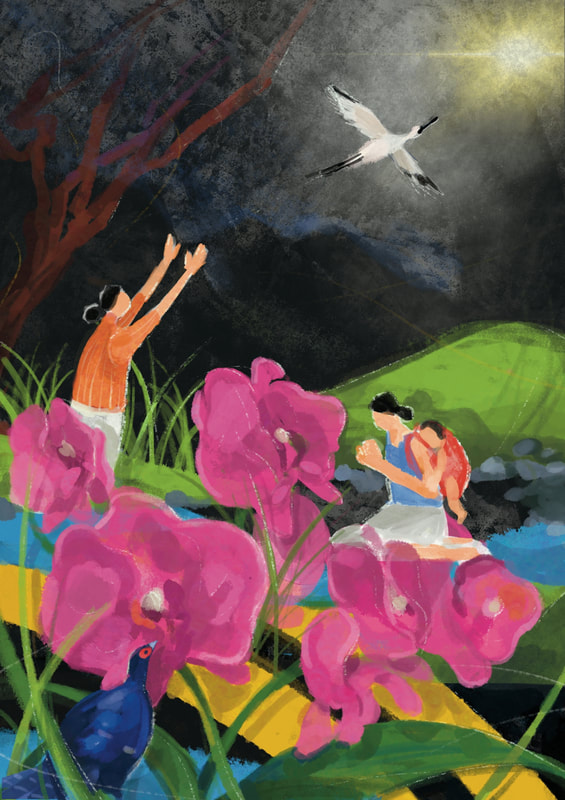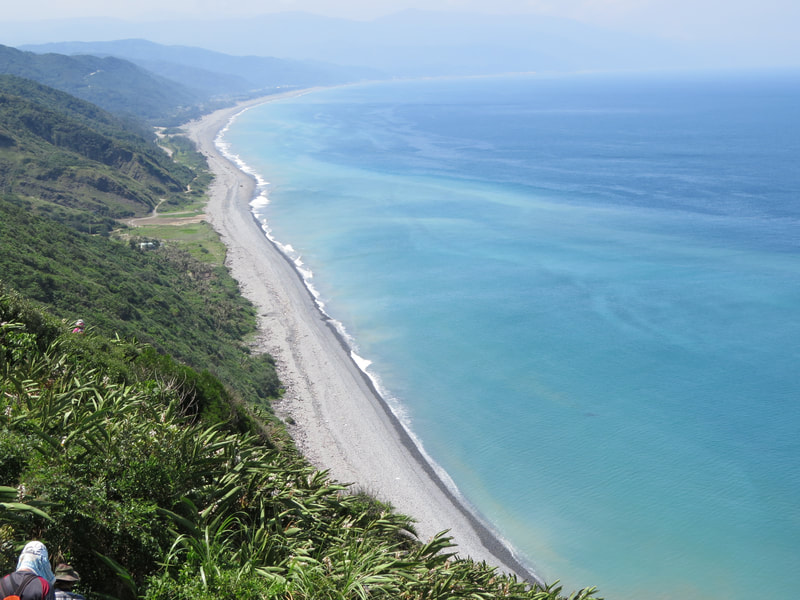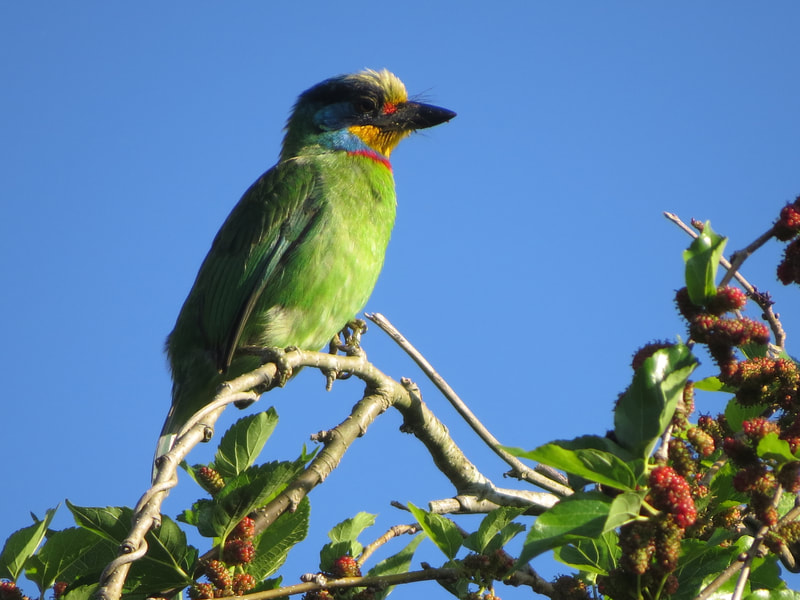I Have Heard About Your Faith
Ephesians 1:15-19
March 3, 2023
|
The artist, Hui-Wen HSAIO, used several motifs that highlight Taiwan’s best-known features to express how the Christian faith brings peace and a new vision to Taiwan.
The women in the painting are sitting by a stream, praying silently and looking up into the dark. Despite the uncertainty of the path ahead, they know that the salvation of Christ has come. The Mikado pheasant and the Black-faced Spoonbill, two endangered species, are both of unique significance to the Taiwanese people. Their distinctiveness symbolize characteristics of the Taiwanese people--confidence and perseverance in times of difficulty. The green grass and Phalaenopsis (Butterfly) orchids stand out against the dark background. They are the pride of Taiwan, which has a worldwide reputation as the “Kingdom of Orchids.” Green grass represents the Taiwanese as simple, confident, strong and under God’s care. |
Land, People & Culture
|
|
Taiwan is located in the Western Pacific region and in the center of the East and Southeast Asia Island Arcs. It is composed of the main island and many offshore islands, including the Penghu Islands, Kinmen, the Matsu Islands, and over 100 other islands and skerries. The western third of the island’s terrain consists of plains, basins, hills, and plateaus and is home to over 20 million people. The capital city--Taipei City—sits in northern Taiwan while other major cities run long the west coast.
There are nine national parks in Taiwan. Among them, the Taroko National Park attracts the most tourists with its splendid gorge scenery. The unique island geography and climate conditions have resulted in the considerable diversity of animal and plant species. Hot and cold springs containing different levels of various minerals can be found throughout the country, even in rivers and oceans. With an approximate population of 23.6 million people, Taiwan is a densely populated multi-ethnic country. The characteristic of Taiwan as a society of immigrants is also reflected in its language, with the 16 officially recognized indigenous languages. People who are enthusiastic about staying healthy are often seen jogging or practicing tai chi or Baduanjin qigong (eight-sectioned exercise) at parks near their homes. Praise dance, which was developed by Christians, is not only a fitness activity but also a way to attract people to Christianity. |
The WDP Taiwan CommitteeThe earliest record of Taiwan church women’s participation in the World Day of Prayer dates back to March 1935 in the Taiwan Church Press. Since then, WDP has become an ecumenical prayer worship service that is familiar to the ears of Taiwanese Christian women. Each year, the worship handbook is translated into 13 languages including Mandarin-Chinese, Taiwanese, and indigenous languages that are used during worship services.
Each January, women from the Presbyterian Church in different regions take turns holding a demonstrative WDP worship service during their national women’s training. Afterwards, each representative returns to her respective region and carries out the worship service in March. The cross-denomination national committee led by YWCA includes representatives from other denominations (including the Catholic church) and church organizations. It holds a few WDP worship services for adults and children each year. In 2017, the WDPIC accepted Taiwan’s proposal to write the worship service materials for 2023. This certainly opened up an opportunity for the two WDP committees in Taiwan to collaborate. Thus in 2020, the two committees formed four writing working groups, and the process of working in conjunction has brought the WDP movement in Taiwan an opportunity of mutual exchange and dialogue to seek a state of unity in faith and love between the two committees. While diverse opinions remain among the different denominations in terms of politics and social issues, the Christian faith has led us to go beyond the chasm of ethnicity, historical wounds, and disagreements in real life, so that we may work together for the gospel in which we so believe. |
The Theme“I have heard of your faith in the Lord Jesus and your love toward all the saints, and for this reason I do not cease to give thanks for you as I remember you in my prayers. I pray that the God of our Lord Jesus Christ, the Father of glory, may give you a spirit of wisdom and revelation as you come to know him, so that, with the eyes of your heart enlightened, you may know what is the hope to which he has called you, what are the riches of his glorious inheritance among the saints, and what is the immeasurable greatness of his power for us who believe, according to the working of his great power” (Ephesians 1:15-19) The theme of the WDP 2023 program is based on Ephesians 1:15-19, the letter sent to a faith community to express gratitude. Paul gave thanks to God for the Ephesians living out their love and faith, and prayed that they could see these three truths: the hope to which God has called the disciples, the riches of God’s glorious inheritance among the saints, and the immeasurable greatness of God’s power.
God’s calling has a meaning and a purpose. Oftentimes we are frustrated by difficulties and obstacles and may even lose our hope and faith or rely on our weak human nature. However, we are called to keep our “hope and faith” in God’s kingdom and promises. Through the enlightenment of the Holy Spirit, we come to see the faithful, loving, and gracious God. We regain our hope and faith to face the challenges and move forward. As it was written in Hebrews 11:1, “Now faith is the assurance of things hoped for, the conviction of things not seen.” Throughout the letter, the author shared his prayers for the saints in the trust that they could grasp how wide and long and high and deep the love of Christ is (Ephesians 3:18). Should we be willing to respond to that love by living not for ourselves but for God? The love of Christ may be revealed through our actions, which will point to God’s glorious and abundant inheritance! What are the stories of faith that you have heard? |
Activities for Children
|
|
Making a Head Wreath
Indigenous people in Taiwan are very particular about headwear. It not only represents social status but also contains rich cultural connotations. A head wreath is made by twining flowers and leaves into a circle. It expresses the cultural heritage of unity. The meaning of a wreath varies, depending on different occasions. Sometimes it means welcoming the clansmen who return home from hunting in faraway fields. It can also mean a sign of respect one has towards the recipient of the wreath.
In making a head wreath, let us think about Taiwan, a country which appears to be so small compared to others in the world and which is yet full of God’s abundant mercy and justice. Just like the ways of making head wreaths, we are all different. However, God connects us with love and makes us become a beautiful wreath to witness His presence. |
|
Taiwan GO GO GO
The aim of this game is to learn about the characteristics of Taiwan. This game is a variation of the classical hand game “Rock, Paper, Scissors”. It is usually played between two people, in which each player simultaneously forms one of three shapes with an outstretched hand. Begin the game by posing the action marked START. The winner of each round poses the next action and looks for someone posing the same action to play the game with. The loser of each round must pose the action marked START and start the game over. The game is finished when someone reaches the last action marked WINNER.
|

















